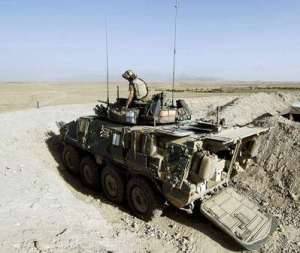 SOTF troopers storming the hijacked MV Avatar after rappelling from a Super Puma helicopter.
SOTF troopers storming the hijacked MV Avatar after rappelling from a Super Puma helicopter.Armed with explosives, the hijackers demanded the release of some detained terrorists. Failing which, they would sail the MV Avatar into Jurong Island and detonate the ship.
This was the scenario participants at Exercise Northstar VIII were faced with on 25 Nov. The exercise, which simulated multiple terrorist attacks at various locations in Singapore, was held from 10 to 25 Nov to test the whole-of-government approach in handling such emergencies.

In response to the hijacking simulation at sea, exercise participants despatched two patrol vessels from the Republic of Singapore Navy (RSN) and the Police Coast Guard (PCG) to flank the MV Avatar while they negotiated with the hijackers.
When negotiations stalled and the MV Avatar proceeded at full speed towards Jurong Island, the Special Operations Task Force (SOTF) moved in. The SOTF troopers approached via two Rigid Hull Inflatable Boats (RHIBs) and a Super Puma helicopter, and proceeded to board and storm the ship while the another helicopter provided air cover.

This successful operation was made possible through a well-oiled National Maritime Security System (NMSS). Involving various maritime security agencies, the new framework enables the early detection of maritime threats and provides a timely and coordinated response to these threats.
It comprises a National Maritime Sense-making Centre (NMSC), which collates and analyses maritime information round-the-clock, and a National Maritime Operations Group (NMOG), which carries out operations to neutralise maritime threats.
Deputy Prime Minister, Coordinating Minister for National Security and Minister for Home Affairs Teo Chee Hean, who visited the final day of Exercise Northstar, also officially launched the Singapore Maritime Security Centre in Changi Naval Base.

After observing how the NMSS was tested through the simulated hijacking incident, he commented on the importance of the NMSS: "There's so much traffic in the maritime domain going on around us; we're one of the busiest ports in the world, so to be able to detect, sense-make and understand the threats developing and to pre-empt them before they occur is a very important first step.
Besides the sea simulation, Exercise Northstar also featured a chlorine leak simulation followed by blasts caused by vehicle-borne improvised explosive devices (IEDs) in Jurong Island on the same day. This simulation saw the Singapore Civil Defence Force (SCDF) containing the crisis, evacuating and treating casualties together with personnel from the Singapore Armed Forces (SAF) and the Ministry of Health.

He also cautioned against complacency, saying: "We can never be too ready, so we always have to keep on practising. We must understand that the threats are unpredictable, so we cannot just be training for a specific threat, but we must have the flexibility to respond as the threats evolve."
Besides Mr Teo, Minister for Defence Dr Ng Eng Hen, Senior Parliamentary Secretary for Defence and National Development Dr Mohamad Maliki Bin Osman and senior officials from various ministries were also present to witness the exercise.











 The US Navy (USN) will operate with nine carrier strike groups (CSGs) by the end of the year, reducing the effectiveness of the service's 11-carrier force.
The US Navy (USN) will operate with nine carrier strike groups (CSGs) by the end of the year, reducing the effectiveness of the service's 11-carrier force.


 Hsiung Feng 3 supersonic anti-ship cruise missile powered by ramjet
Hsiung Feng 3 supersonic anti-ship cruise missile powered by ramjet 














